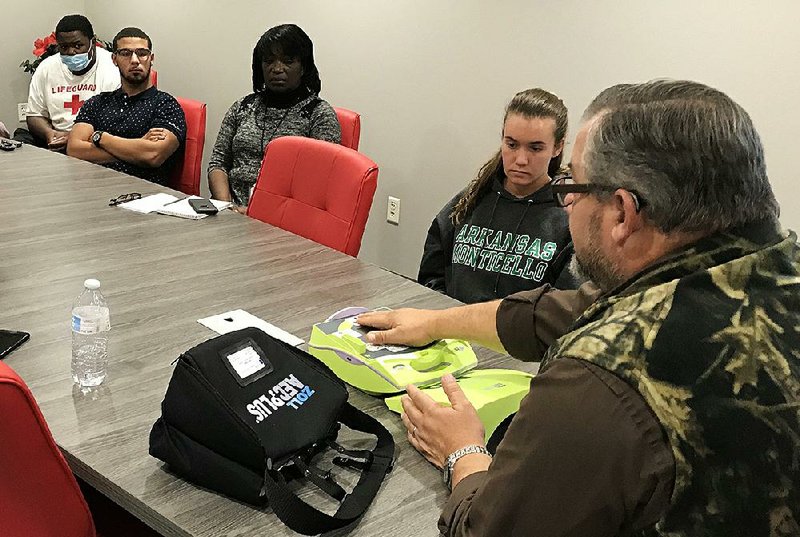PINE BLUFF -- The Pine Bluff Aquatic Center has received a new tool to aid lifeguards and other personnel in providing aid in the event of medical emergencies -- an Automated External Defibrillator.
The Zoll AEDPlus automated external defibrillator was donated to the Aquatic Center by Emergency Ambulance Service Inc., Jefferson County's emergency transport service. The $2,000 cost of the defibrillator was covered by a grant obtained by the ambulance service, Emergency Ambulance Service Chief Executive Officer Josh Bishop said.
"This is the second one we've donated to the city of Pine Bluff this year," Bishop said. "The first one went to the fire department. We're trying to match them every time they buy one because they help us so much in the community, and then we wanted to have one out here, too, just to help that much quicker with patient care in case it's needed out here."
The defibrillators are portable, life-saving devices designed to treat people experiencing sudden cardiac arrest, a medical condition in which the heart suddenly and unexpectedly stops beating, according to the U.S. Food and Drug Administration.
The defibrillator system includes accessories, such as a battery and pad electrodes that are necessary for the defibrillator to detect and interpret an electrocardiogram and deliver an electrical shock. There are two main types: public access and professional use.
Public access defibrillators can be found in airports, community centers, schools, government buildings, hospitals and other public locations. They are intended to be used by laypeople who have received minimal training.
Professional-use defibrillators are used by first responders, such as emergency medical technicians and paramedics, who receive additional defibrillator training.
Defibrillators can be semi-automated or fully automated.
Semi-automated defibrillators analyze the heart's rhythm, and if an abnormal heart rhythm is detected that requires a shock, then the device prompts the user to press a button to deliver a defibrillation shock.
Fully automated defibrillators analyze the heart's rhythm and deliver a defibrillation shock if commanded by the device software without user intervention.
Training for the dozen lifeguards and staff members of the aquatic center was conducted by John Badgley, operations director of Emergency Ambulance Service, who stressed that, while the unit itself is fully automated, it requires training to be used properly.
"The problem that you're going to have with an AED," Badgley said of the defibrillator, "is your environment. When your environment is unsafe to begin with, you can't just pull somebody out of water, put them on the side of the pool and shock them. It's not only going to shock the patient, it's going to shock you as well."
Badgley stressed that the electrical current that can be generated by a defibrillator is sufficient to kill a human being if used improperly.
"This thing starts at 120 joules," he said. "A joule is about six volts, nearly seven volts, so you do the math."
Badgley explained how the device works to re-polarize the heart when it has stopped and how to use it safely to resuscitate a person. In addition, he told the employees that he would work with Sandra Courtney, the Aquatic Center director, to stock the center's first aid room with needed accessories.
"This does just about everything that needs to be done," Courtney noted, remarking on the automated features of the device. "We just have to be aware of what we need to do."
Bishop said the eventual goal with the program is to supply defibrillators anywhere they may be needed, although at nearly $2,000 each, he said grant funding is crucial to being able to supply the units.
"There's a little bit of a lead time to getting that done," Bishop said. "Anywhere they're needed ... any kind of public safety premises where it might be helpful to elicit a quicker response, that's where we want to put them."
Bishop said many facilities, such as the Pine Bluff School District, the Jefferson County Courthouse, and other places, already have defibrillators available, and he added that the East Ambulance Service has worked to obtain the devices for entities outside of Jefferson County as well.
"We've done it in Cleveland County at the courthouse, so anyplace we serve, we try to donate one a year or, whenever we're asked, we try to make it happen," he said. "Now, here in the city, between us and the fire department, we have very fast response times, so hopefully, by the time someone gets the thing out and figures out how to hook it up, we'll be there to do it for them."
Bishop said any entities that already have defibrillators in place may contact Emergency Ambulance Service for training if desired.
"It's free of charge," he said. "All they need to do is call and ask."
State Desk on 11/19/2019
